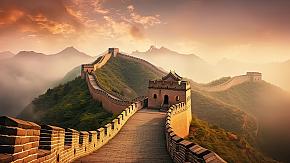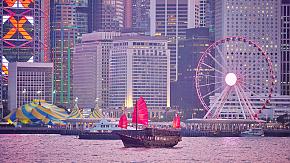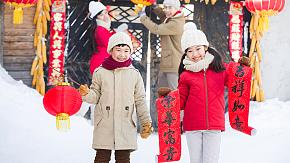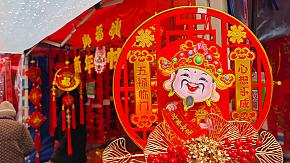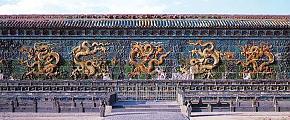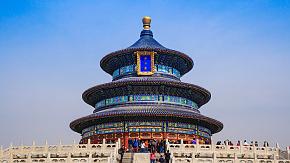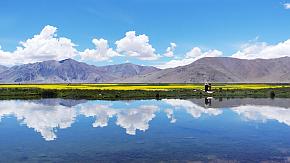Chinese Lantern Festival: Traditions & History
The Lantern Festival marks the end of the Spring Festival celebration, falling on the 15th day of the lunar New Year. In 2026, the Lantern Festival will be on March 3rd. On this day, families will reunite again and have dinner together. After the meal, we will go out and enjoy the lantern shows, which are held in parks or streets.
If you're planning to celebrate this special holiday on your trip to China, it's wise to learn about the history and traditions of the Lantern Festival before setting off for your journey.
Origin of the Lantern Festival
 Lanterns for the New Year & Lantern Festival
Lanterns for the New Year & Lantern Festival
There are many origins and legends associated with the Lantern Festival. According to historical records, the festival dates back to the Han Dynasty. One legend suggests that the Lantern Festival originated from Buddhism. On the 15th day of the first lunar month, Emperor Ming of Han ordered lanterns to be lit to honor Buddha. In Buddhism, light holds great significance as it symbolizes the dispelling of darkness in the world and the illumination of all beings.
The second version of the Lantern Festival legend is about Emperor Wu of Han. He held a sacrificial ceremony on the 15th day of the first lunar month to honor the heavenly gods, making this day an important festival.
Another legend tells a different story of this festival. In ancient times, there were many fierce birds and beasts that harmed humans. To protect themselves, people organized hunts. One day, a divine bird lost its way and landed in the mortal world but was accidentally shot by unaware hunters. The Jade Emperor, enraged upon learning this, ordered a fire to engulf the mortal world on the 15th day of the first lunar month.
The Jade Emperor's daughter, unable to bear this punishment, secretly came to the mortal realm to warn the people. To deceive the Jade Emperor, people devised a plan: on the night of the 15th, they decorated their homes with lanterns and lit fireworks to make it appear as if the world was already ablaze. This plan successfully tricked the Jade Emperor, sparing humanity. Since then, people have hung lanterns every year on this day to commemorate the occasion.
Traditions of the Lantern Festival
1. Have a reunion meal with families
 Family reunion meal on Lantern Festival
Family reunion meal on Lantern Festival
The Lantern Festival is a public holiday in China. We will get a day off for this holiday. The 15th day of the first lunar month is the first full moon night of the year. In Chinese culture, the round moon symbolizes reunion. Thus, we will get together with our families, decorate our home with red lanterns, and have a dinner together to celebrate the last day of the lunar New Year celebration.
2. Attend a Lantern Show
 Huge dragon lantern at a lantern show
Huge dragon lantern at a lantern show
This is a massive thing to do for Chinese people. After dinner, we will go out to the parks or streets to admire the lanterns in different shapes and colors. In lantern shows, the lanterns come in various shapes and colors, no longer limited to the traditional red and yellow used during the Chinese New Year. For example, the Yuyuan Garden hosts a lantern festival every year, with a different theme each time, often incorporating the zodiac animal of the year.
The upcoming Yuyuan Lantern Festival in 2025 is themed "Zhuang Zhou's Dream of Being a Butterfly," inspired by the story from Zhuangzi: On the Equality of Things. This festival will feature a magical dreamlike world created by giant lanterns in the shapes of butterflies, whales, flowers, and more. The Yuyuan Lantern Festival will run from Jan. 1st to Feb. 12th (excluding New Year's Eve, Jan. 28th). Lanterns will be lit daily after 4 PM. Tickets are priced from 30 to 80 yuan.
Apart from admiring it, there's one more interesting thing to do with lanterns: solving lantern riddles. These riddles are written on paper and hung on different lanterns. Here we prepare an English riddle for you: What is the giant pandas' biggest regret in their life? Read and find the answer at the end of this article!
3. Have Yuanxiao at Home
 Yuanxiao, also called glutinous rice balls
Yuanxiao, also called glutinous rice balls
Yuanxiao, also called glutinous rice balls, is a traditional festive food in China during the Lantern Festival. Its round shape symbolizes the reunion of families and hope for a prosperous year ahead. Yuanxiao has soft skin, which is made from glutinous rice flour. The fillings can be different. The most classic fillings are sesame paste and peanut butter. To satisfy younger generations, you can also find yuanxiao with jams as fillings.
Generally speaking, most people buy yuanxiao directly from supermarkets and cook them at home by boiling water, much like cooking noodles. However, we usually don't add any seasonings to yuanxiaos, as the rich and flavorful filling is revealed with each bite. Yuanxiao is often served in bowls. Each bowl of Yuanxiao has about 6 to 10 balls.
Different Colors of Lanterns
It is worth noting that different colors of lanterns carry distinct meanings in Chinese culture. If you wish to celebrate the Spring Festival and Lantern Festival, be sure to carefully choose the lantern colors.
Red
 Classic red lanterns for Lantern Festival
Classic red lanterns for Lantern Festival
Red lanterns are one of the most common decorations of the lunar New Year. In Chinese culture, red is a symbol of happiness and good fortune. Apart from the lanterns, the paper cuttings and paper couplets are basically red.
Gold/Yellow
Yellow was actually the color of emperors and empresses in ancient times. Since it's the color of gold, it also has a meaning of wealth. Therefore, it is often used as a secondary color in Spring Festival decorations, such as red lanterns adorned with yellow trim, wishing to make more money in the upcoming year.
White
 Bunny lanterns for the Mid-Autumn Festival
Bunny lanterns for the Mid-Autumn Festival
Please keep in mind that not all the festivals use white lanterns. In ancient China, white symbolized mourning. When a family member passed away, people would hang pure white lanterns under the eaves of their doorways to inform neighbors of the situation.
Nowadays, white lanterns with special meanings are often designed with unique decorations or shapes to differentiate them from traditional ones. For instance, white rabbit-shaped lanterns for the Mid-Autumn Festival or artistic white lanterns featuring Chinese calligraphy. However, these lanterns are not used during the Spring Festival either.
Green, Blue & Other Colors
 Lanterns in vivid colors
Lanterns in vivid colors
Other vivid colors, like green, blue, or pink, actually have no special meanings in Chinese culture. These colors are widely used in artistic lanterns to fit various themes. Such lanterns will be displayed during the New Year celebrations. For example, if it is the Year of the Rat, gray rat-shaped lanterns might be created.
Tips for Exploring China During the Lantern Festival
1. Book in advance. The Lantern Festival events are highly popular every year, no matter they are free or ticketed. To attend, it's often necessary to book in advance. At China Odyssey Tours, we can help you book tickets and plan your itinerary to avoid peak crowd times as much as possible.
2. Join in a guided tour. A local guide can answer all the cultural questions when you celebrate this festival. When you find a lantern with a unique shape, your guide can explain the meaning of this lantern to you. Besides, you can tell your guide about what you prefer or don't like; he or she will help you communicate with hotels or restaurants.
3. Check weather conditions. During the lunar New Year and Lantern Festival, it's still cold in China, especially at night. Since most of the lantern shows open at night, we strongly recommend you wear a thick hat and gloves to keep warm.
In the end, it's time to reveal the answer. The answer to this riddle is a colorful photo. Because giant pandas only have black and white fur. They will only get black-and-white photos.
China has more traditional festivals for you to explore, such as the Dragon Boat Festival and the Mid-Autumn Festival. All of these festivals are different, with unique cultures and traditions. Contact us or write to trip@odynovotours.com for a customized festival-themed trip to China.
Related Posts You May Like
What Our Clients Say
"Great Customized Service", "Trip of A Lifetime", "Exceed All Expectations"

